
Getting the UN climate change treaty’s 198 signatories to agree on anything unanimously is difficult. Especially when the topic is as controversial as Article 6 of the Paris Agreement, which governs international emissions trading. It’s no surprise, then, that the historic agreement on Article 6 reached at this year’s Conference of the Parties has caused headlines and celebration. At one dinner I attended in Baku, our host literally raised a toast to the draft Article 6 guidelines. Yalchin Rafiyev, COP29’s Lead Negotiator, hailed the progress as “a game-changing tool to direct resources to the developing world and help us save up to 250 billion dollars a year.”
Article 6 allows companies and countries in the Global North to fund emissions reductions in the Global South and to claim those reductions towards their own pledges. A functioning Article 6 market would let rich countries reach ambitious climate targets while providing climate finance for cash-strapped developing countries. A win-win. Although some have criticized this as “buying your way out” of decarbonization, governments and companies would much rather spend money on productive green investments at home than buy carbon credits abroad. This means Article 6 will principally be used when targets would otherwise be missed, or as a “top-up” over existing goals.
According to negotiators who have been debating Article 6 for the last decade, the COP29 agreement is the final hurdle to unlocking billions of dollars in climate finance. In actuality though, what happened in Baku is more prosaic. On the first day of the conference, the Article 6 committee approved a set of recommendations on eligibility criteria for carbon trading. Next, the committee spent two weeks adding guidance to the recommendations. Now, with the text approved by the COP plenary, the UN can start approving methodologies to certify emissions reductions credits from clean energy and carbon removal projects.
The metaphor most widely used for the “breakthrough” at COP29 is opening a floodgate. Break down the barrier – the need for UN guidelines – and a rush of financing will unleash. According to this view, what’s stopped billions of dollars in carbon finance from flowing to developing countries has been the need for “gold standard” methodologies to ensure trust in Article 6 credits’ environmental integrity.
Unfortunately, while an attractive metaphor, there is no flood of climate finance behind the dam waiting to burst forth. This year less than one billion dollars has been spent on voluntary carbon credits. That’s under one tenth of one percent of the $1.3 trillion demanded by developing countries and still only a fraction of the $300 billion pledge eventually agreed at COP29. Voluntary carbon market boosters claim that if companies trust they can buy genuine emissions reductions, then finance will flow. In truth, however, in a capitalist economy, CEOs don’t spend billions of dollars when they don’t have to. Companies spending large shares of their revenue on voluntary credits, as some pollyannaish reports expect, would be sued for wasting shareholder capital, and the plaintiffs would likely win.
A better metaphor for operationalizing Article 6, rather than destroying a dam, is building a space station on the Moon. Writing international rules to govern the lunar base will be important. Approved UN regulation could even catalyze interest in extraterrestrial investment. But the hard part of building a Moonbase is building a Moonbase, not writing regulation. And make no mistake, the hard part of funding climate projects is getting funds for climate projects, not passing resolutions. In other words, what’s holding back Article 6 isn’t a lack of UN guidance, it’s money. The problem isn’t regulation governing the supply of credits, it’s demand from buyers willing to purchase them.
Luckily, the world is not without tools. Currently, the largest demand for Article 6 credits comes from Switzerland, Singapore, and Japan. Do the Swiss, Singaporeans, and Japanese care more about climate change than their neighbors? No, but these countries have mandatory carbon taxes which firms pay in part with Article 6 credits. That makes the purchase of credits mandatory, and a CFO’s legal responsibility. This is the key to Article 6 – giving value to the credits as a "carbon tax asset" – which firms must buy to pay off their "carbon tax liabilities."
If carbon taxes are the dealbreaker for carbon finance, then the biggest news from COP29 is not the Article 6 agreement but instead a more obscure development in the form of a “Presidency Consultation,” agreed this year in Baku. Through this Consultation, for the first time, a particular carbon tax known as a carbon border adjustment is being discussed within the UN climate conference.
What does this have to do with Article 6? Carbon border taxes will create tens of billions of dollars in carbon tax liabilities on goods exported into jurisdictions like the EU. If purchasing Article 6 credits were one way to pay a carbon border tax bill, it could scale carbon markets by orders of magnitude and create a new “carrot” for developing countries worried about the effects of the carbon border taxes.
Carbon border taxes represent a huge opportunity to generate demand for Article 6 credits. Over the next year we’ll be publishing research from Harvard’s Belfer Center on how linking border taxes and carbon markets could work in practice. This will be a long road, as turning Article 6 into real clean energy investment is no simple task. But then again, moonshots never are.
Sandler, Ely. “Article 6 at COP29: The Challenge for Carbon Markets Is Demand, Not Supply.” Belfer Center for Science and International Affairs, November 26, 2024


